Top 9 Mekong Delta Food Specialties To Try When Visiting
The Mekong Delta is more than just a destination for travelers drawn to its serene rivers and lush landscapes; it’s a culinary haven waiting to be explored. For food enthusiasts, the region offers an unforgettable journey through rich flavors and time-honored recipes.
In this article, Joy Journeys invites you to embark on a culinary adventure and discover the Mekong Delta food specialties that make this region a true paradise for gourmands.
Contents
- 1 Top 9 Mekong Delta food specialties that you should try
- 1.1 Bun Mam (fermented fish noodle soup)
- 1.2 Bun Nuoc Leo (rice noodles cooked with fish broth)
- 1.3 Banh Khot (mini rice pancake)
- 1.4 Hu Tieu My Tho (My Tho noodle)
- 1.5 Banh Pia (Bakpia/Hokpia)
- 1.6 Banh Bo Thot Not (baked honeycomb cake)
- 1.7 Banh Xeo (Vietnamese pancake)
- 1.8 Canh chua ca (sour fish soup)
- 1.9 Ca Kho To (braised fish)
- 2 Tips for exploring Mekong Delta culinary experiences
- 3 Experience traditional Mekong Delta dishes tour with Joy Journeys
- 4 Conclusion
Top 9 Mekong Delta food specialties that you should try
Join us as we explore the top 9 regional Mekong Delta food specialties that will make your journey through this vibrant region more enjoyable.
Bun Mam (fermented fish noodle soup)
One of the top specialties of the Mekong Delta is ‘bun mam’. This dish is beloved for its unique broth, made from ‘linh’ or gourami fish sauce, both of which are abundant in the Southwest, particularly in Tra Vinh and Soc Trang.
In the past, ‘bun mam’ was a simple, rustic dish often prepared for quick meals. The fish sauce was cooked until dissolved and then filtered to obtain a clear broth. A bit of sugar, lemongrass, and onions were added before serving. Over time, to enhance the flavor and richness of bun mam, people began adding fish pieces, shrimp, squid, and roasted pork.
Bun mam is typically enjoyed with a variety of fresh vegetables such as water spinach, lotus stems, bitter greens, banana flowers, bean sprouts, and fish mint.
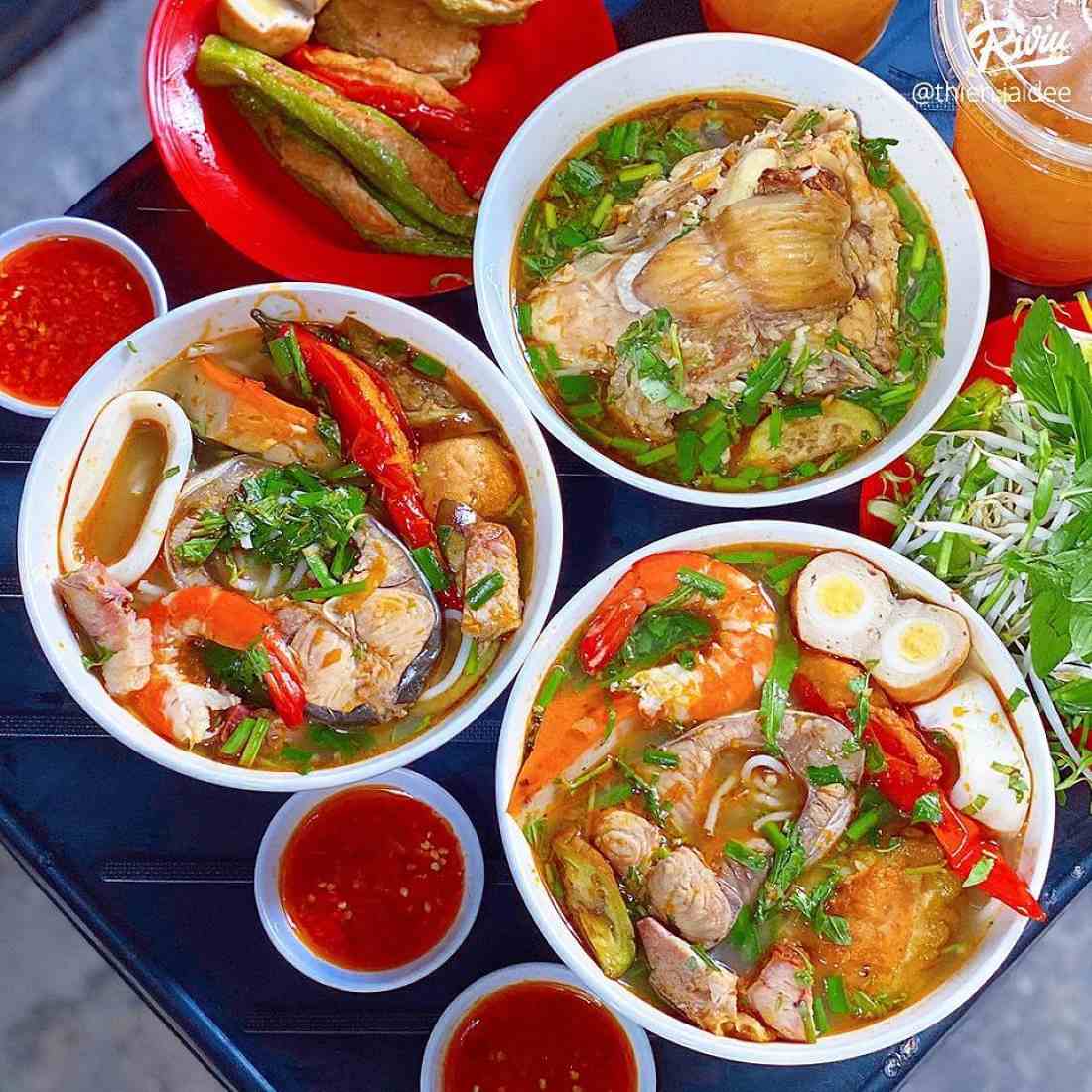
Bun Nuoc Leo (rice noodles cooked with fish broth)
‘Bun nuoc leo’ is a famous noodle soup found in many parts of Southern Vietnam, particularly in provinces like Soc Trang, Tra Vinh, Chau Doc, Ca Mau, and Bac Lieu.
Originally a culinary specialty of the Khmer people, ‘bun nuoc leo’ has become a typical dish across Southern Vietnam through cultural exchange among the Khmer, Vietnamese, and Chinese ethnic groups. Despite slight variations, the ingredients, preparation methods, and flavors are generally the same among these communities.
The ingredients for a bowl of ‘bun nuoc leo’ are wonderfully varied, including fish sauce (made from ‘linh’ fish, snakehead fish), rice noodles, fresh coconut water, snakehead fish, roast pork, freshwater shrimp, fish sauce, chili, vinegar, basil, perilla, bean sprouts, and banana blossom.

Banh Khot (mini rice pancake)
‘Banh khot’ is one of the traditional Mekong Delta dishes. Made from rice flour or tapioca flour and filled with shrimp, it’s fried to perfection and served with fresh vegetables, chili, and sweet fish sauce for dipping.
The most important step in making ‘banh khot’ is preparing the dough. It is made from rice flour, crispy flour, and turmeric powder, all mixed and stirred into a smooth paste. The flours are mixed in a ratio mainly based on experience. However, ready-made ‘banh khot’ flour is also available in stores. The filling is typically fresh, medium-sized shrimp that are carefully peeled to retain their vibrant color.
To prepare ‘banh khot’, heat the round molds in a pan and coat them with hot fat. Pour the batter into each mold, press the shrimp into the center, cover the pan, and wait for the cakes to cook. When ready, the dough turns golden and the shrimp a vibrant red, with fragrant green onions and chives clinging to the cakes.
The accompanying dipping sauce is made from fish sauce mixed with warm water, garlic, and lemon juice.
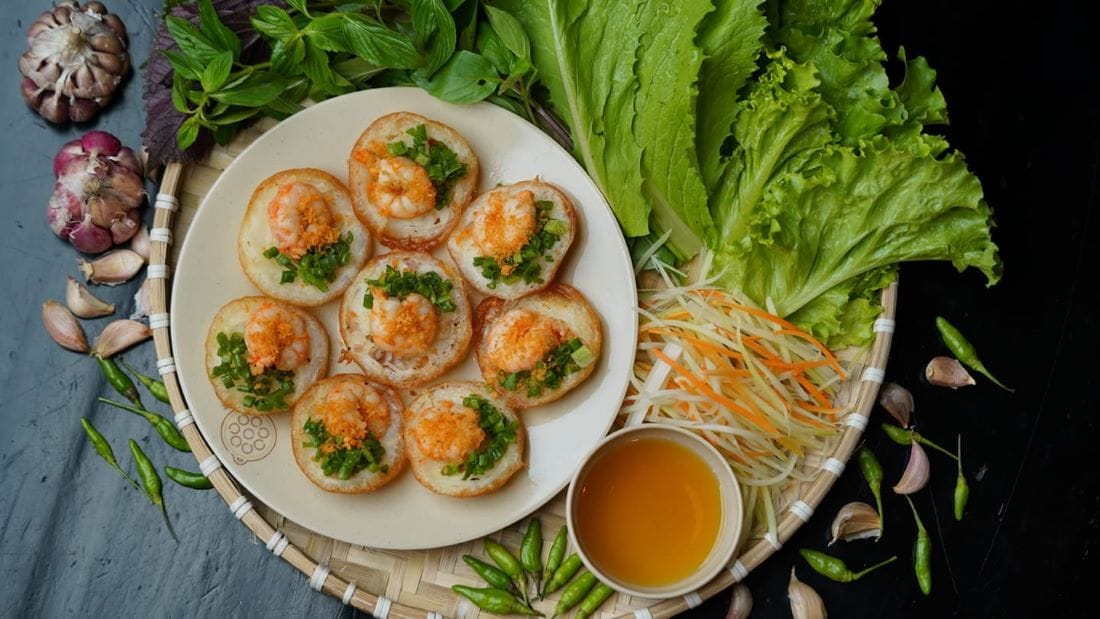
Hu Tieu My Tho (My Tho noodle)
My Tho noodles are a specialty of the My Tho people, primarily made from dry noodles. The rich broth features minced meat and pork intestines cooked with pork bone marrow. The noodles are blanched in the broth and accompanied by additional ingredients such as bean sprouts, chives, minced meat, and pork intestines.
Typically, My Tho noodles include sliced meat, minced meat, pork bones, and liver; some shops even add dried shrimp to enhance the broth’s sweetness. The delightful richness of the bone broth, along with the various ingredients, imparts a distinctive Southwest flavor to the dish.
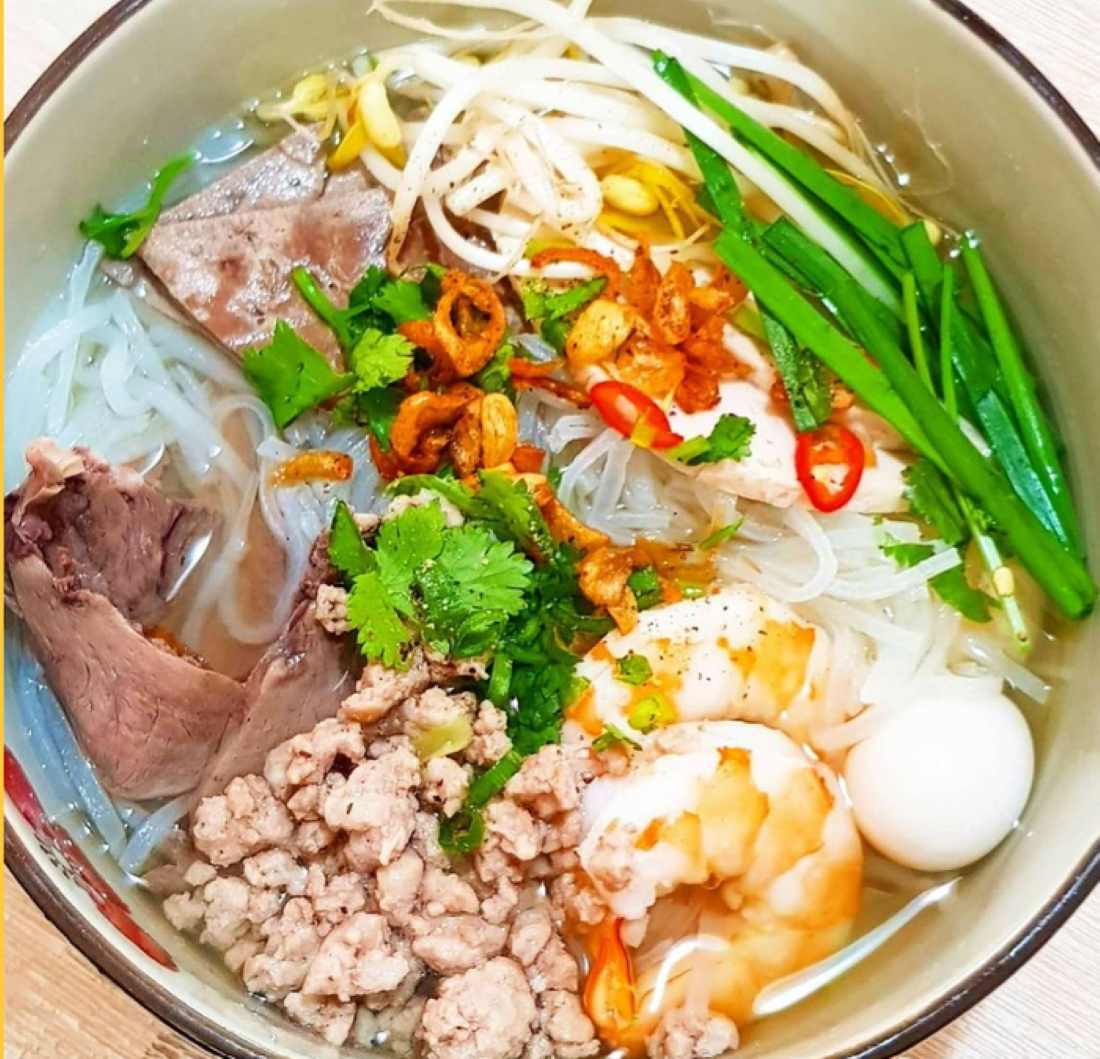
My Tho noodles are often served with toppings such as bean sprouts, fried garlic, lemon, chili, pepper, and soy sauce. The dipping sauce typically consists of soy sauce mixed with a bit of vinegar and sugar.
Banh Pia (Bakpia/Hokpia)
In Vietnam, ‘banh pia’ is one of the specialties of Soc Trang, created by Chinese immigrants in the South. This cake is made from wheat flour kneaded with pork lard. Originally, ‘banh pia’ had a simple recipe, with the outer shell consisting of multiple thin layers of wheat flour covering the filling.
The thicker outer layer was often used to stamp letters, while the filling was traditionally made from green beans and lard instead of salted egg yolks and other ingredients like those used today. In response to changing consumer tastes, bakeries have added flavors such as durian, taro, and salted egg yolks.

Banh Bo Thot Not (baked honeycomb cake)
‘Banh bo’ is a rustic dish from An Giang – a southwestern province of Vietnam. It boasts the fragrant taste of rice wine, the rich flavor of coconut water, and the sweetness of palm sugar, creating a unique flavor and color that you won’t find in traditional ‘banh bo’.
To make this specialty from An Giang, you will need a cake mold, a steamer, and a stove. First, prepare all the ingredients, including ground rice flour mixed with premium palm sugar, and then ferment the mixture with rice wine.
The secret to achieving the unique flavor of ‘banh bo thot not’ lies in the method of mixing the rice wine, ensuring that the dough ferments properly before pouring it into the mold for steaming.
The process of making the cake—from caramelizing the sugar and fermenting the dough to steaming—is extraordinarily elaborate and requires the skill and steady hand of the baker. During the fermentation process, the baker must carefully monitor the time and add a bit of rice wine to accelerate the fermentation, resulting in a cake that is soft, spongy, and delicious once steamed.

Banh Xeo (Vietnamese pancake)
For a long time, ‘banh xeo’ has been an indispensable dish during holidays for people in the river regions of Southern Vietnam. The ingredients used to make banh xeo reflect the rustic simplicity of this area.
The pancake batter is made from rice flour, combined with turmeric for a yellow hue and coconut milk for the richness. The filling typically includes shrimp, pork belly, or minced pork, along with green beans, bean sprouts.
Unlike the smaller, thicker pancakes from the Central region, Western banh xeo is larger, with a thin, crispy crust.
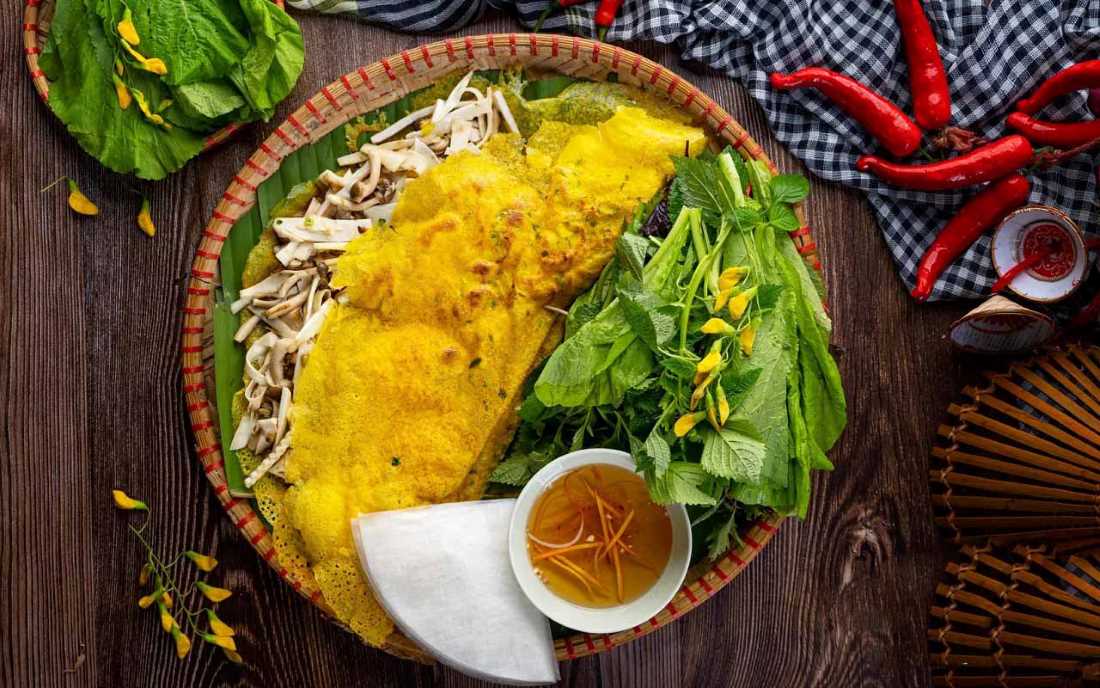
Banh xeo is served with a variety of garden-fresh vegetables, such as toad leaves, coconut shoots, basil, herbs, and cabbage. The traditional way to enjoy it is to wrap a piece of the pancake, along with some filling, add other vegetables, and dip it into a bowl of sweet and sour fish sauce.
Canh chua ca (sour fish soup)
Sour fish soup is a rustic and familiar dish in Vietnamese family meals, especially in the Southwest region. It is usually made with snakehead fish, commonly found in lakes, rivers, and canals.
Once you’ve tasted sour snakehead fish soup, it’s hard to forget the surprising blend of flavors. This dish is a harmonious combination of the sweet taste of snakehead fish, the sourness of tamarind and tomatoes, and the crunchiness of vegetables, creating a unique flavor that truly stimulates the taste buds.
The soup reflects the sophistication of its preparation, using simple yet delicious ingredients that are readily available in the region.
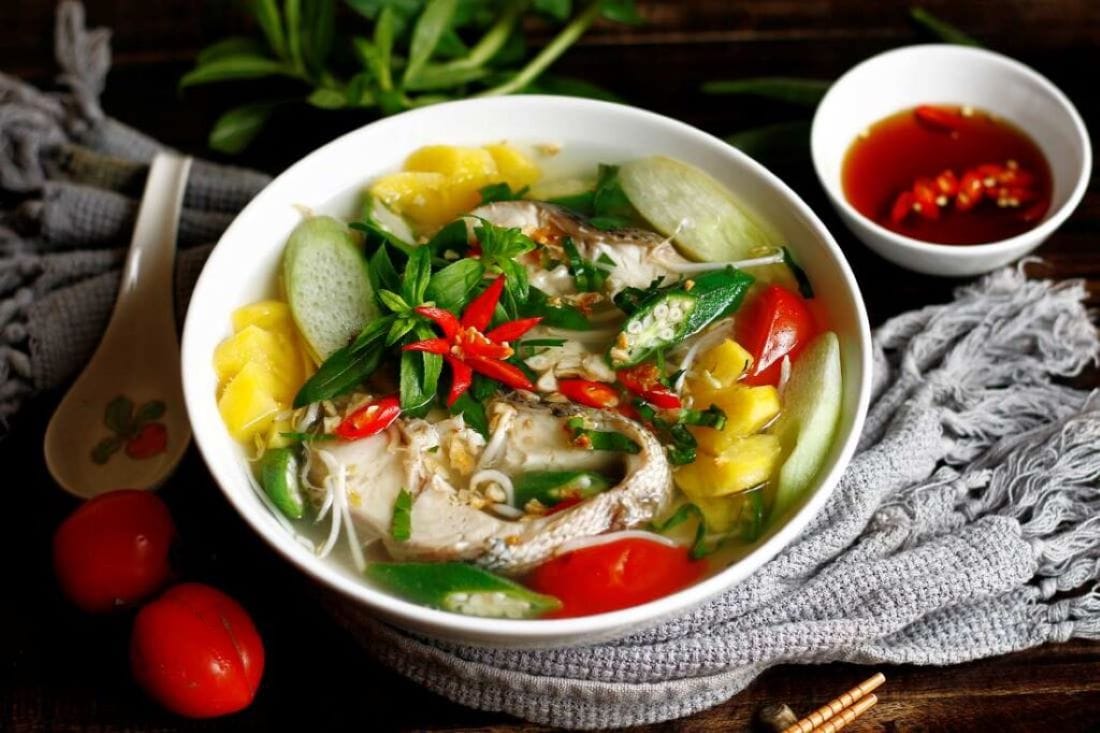
Ca Kho To (braised fish)
Braised fish in a clay pot is a traditional dish of the Mekong Delta, particularly popular in the Southwest region. Though simple, it is incredibly delicious, flavorful, and nutritious.
This dish is typically made from fresh river fish, such as ‘linh’ fish, perch, or snakehead fish, braised in a clay pot or cast iron pan with fish sauce, sugar, garlic, chili, and other spices.
To prepare a delicious pot of braised fish from the Southwestern region, the cook must choose fresh, firm fish. The first step is to clean the fish and cut it into bite-sized pieces, then marinate it with a bit of pepper, garlic, fish sauce, sugar, and more pepper. Next, the fish is braised over low heat for 1 to 1.5 hours until it becomes caramelized.
This dish is best enjoyed with hot rice and sometimes served with cucumber.
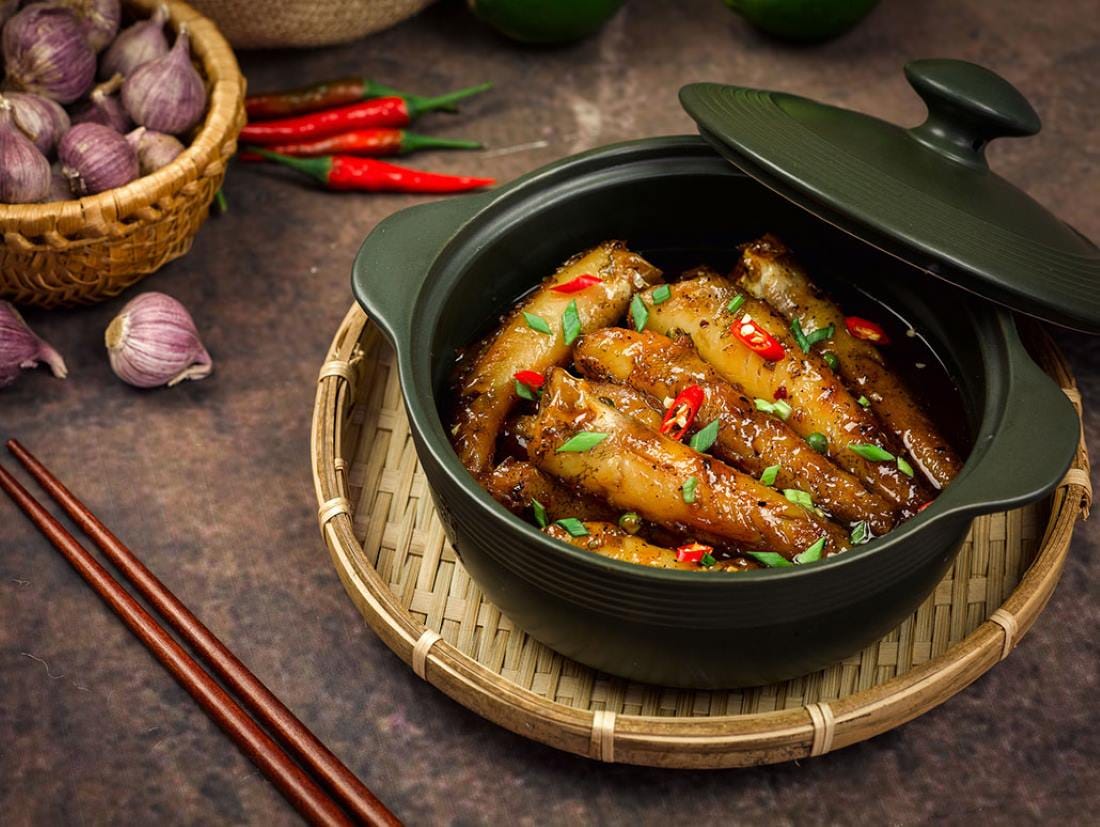
Tips for exploring Mekong Delta culinary experiences
Visit local markets
Local markets are great places to buy ingredients for Southwest specialties, such as fish, fish sauce, and fresh vegetables. These markets are integral to the Mekong Delta culinary experiences, offering a glimpse into the region’s vibrant food culture.
Try street food
Don’t hesitate to indulge in the vibrant Mekong Delta street food scene! The bustling streets are filled with enticing aromas and delicious offerings.
Be sure to try ‘hu tieu’, a savory noodle dish that embodies the region’s culinary charm. Additionally, fresh fruits and a variety of street snacks like ‘banh bo thot not’, ‘banh pia’ and ‘banh xeo’ await you, providing a delightful taste of local flavors that are definitely worth experiencing.
Take a cooking class
If you want to dive deeper into local cuisine, you can book a cooking class. Not only will you savor the food, but you’ll also learn how to prepare the ingredients and create irresistible dishes.
Be adventurous
A trip would only be complete with trying new things, so be bold and taste dishes you’ve never had before. ‘Bun mam’ and ‘bun nuoc leo’ may have strong, unfamiliar aromas, but once you have tried them, they are unforgettable.
Respect local customs
Sharing food is an important part of Vietnamese dining culture. It’s common to pick up food and share main dishes among everyone at the table.
In Vietnam, it is customary to hold rice bowls close to your face while eating. Never eat directly from the serving dish; instead, be patient and place the food in your bowl before eating. Avoid picking through the food, as it’s considered impolite to leave less desirable portions for others.
Experience traditional Mekong Delta dishes tour with Joy Journeys
Cuisine is one of the highlights that Joy Journeys is proud to offer its customers as they explore the Mekong Delta. We prioritize taking you to authentic locations, allowing you to truly savor the local flavors and culinary traditions without the distractions of busy touristy spots.
Whether you’re experiencing the quiet, peaceful routes of Ben Tre or indulging in a home-cooked meal at a local’s house in My Tho, Joy Journeys guarantees a memorable and genuine experience.
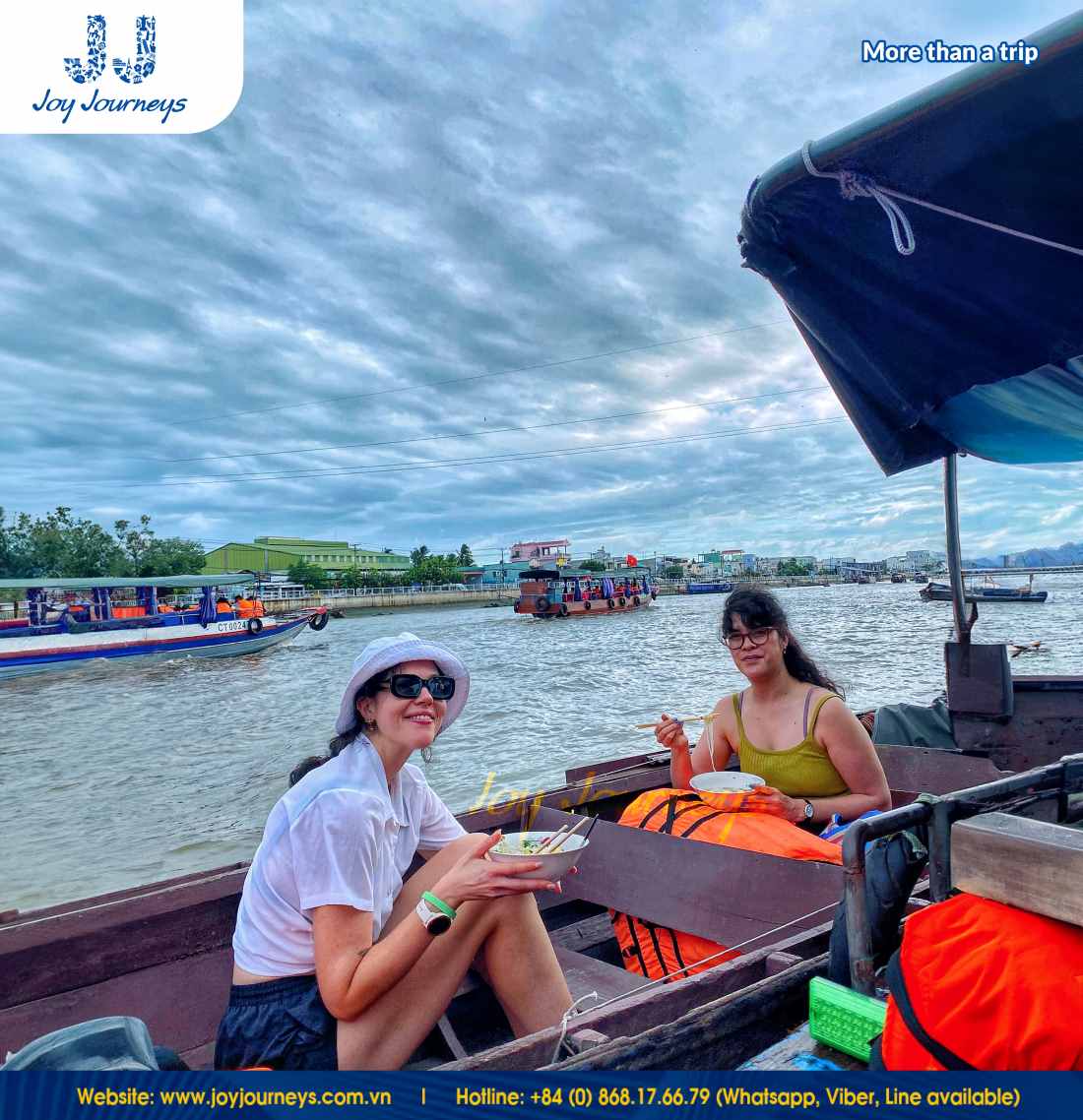
- Enjoy Tropical Fruits: The Mekong Delta is famous for its tropical fruits, a must-try specialty of the region. From the sweetness of mangoes to the distinct flavors of durian and longan, the abundant, fresh fruit selection is sure to satisfy even the most discerning travelers. Sampling these local delights is a refreshing and authentic way to connect with the land.
- Join a Cooking Class and Enjoy a DIY Meal: Immerse yourself in the local culture by joining a hands-on cooking class. Under the guidance of experienced chefs, you can learn how to prepare some of the Mekong Delta’s signature dishes, like crispy banh xeo or fragrant fish dishes. After cooking, you’ll enjoy the fruits of your labor with a DIY meal, savoring the flavors you’ve helped create.
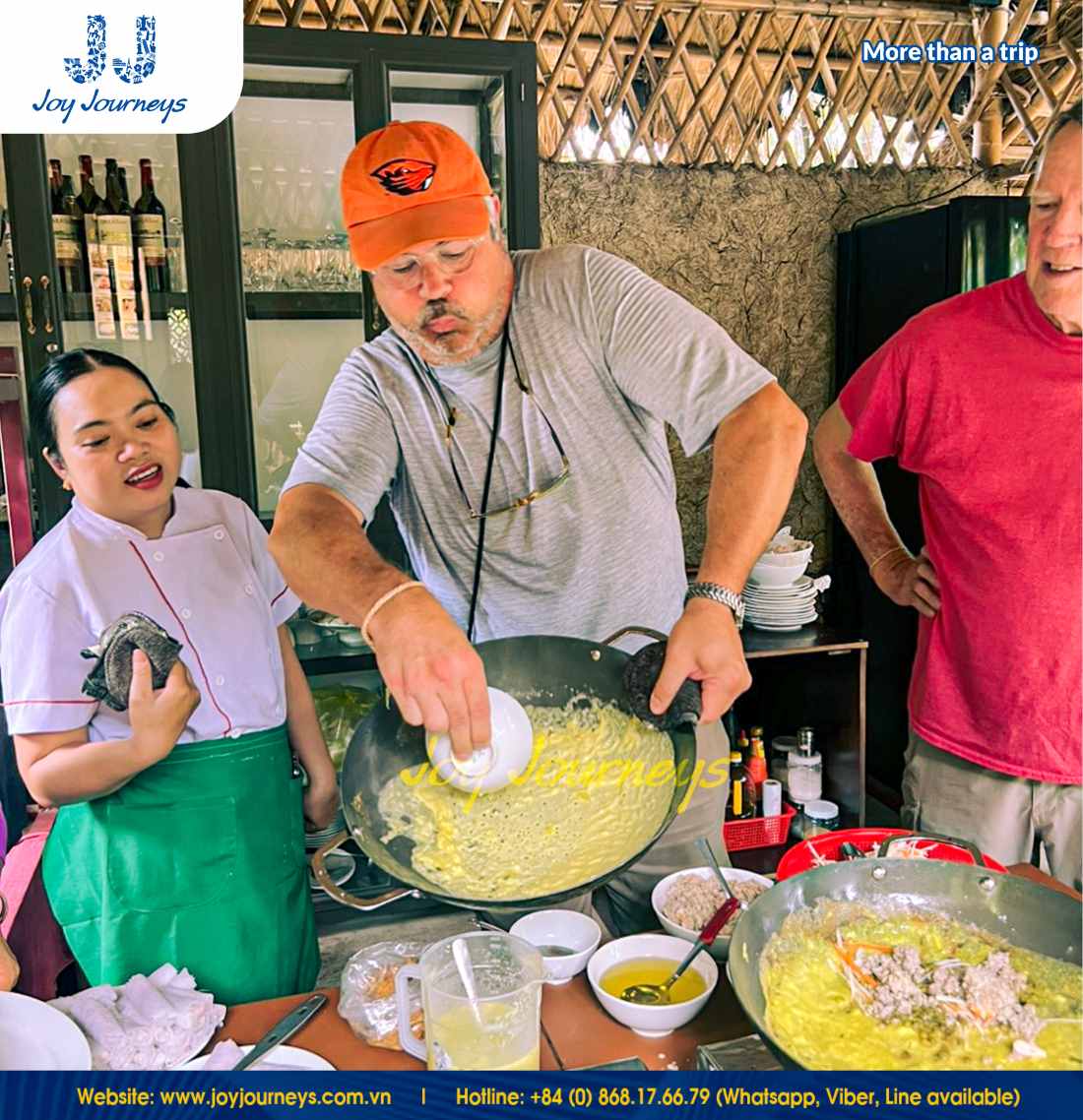
- Have Lunch at a Local’s House with Local Specialties: Experience the warmth of Mekong hospitality by having lunch at a local home. You’ll be treated to a feast of regional specialties, all prepared with fresh, local ingredients. From savory braised fish to vibrant vegetable dishes, every bite offers a taste of authentic Mekong Delta cuisine, served traditionally.
Conclusion
Savor the flavors of the Mekong Delta and indulge in the bountiful gifts nature has bestowed upon this fertile land. With Joy Journeys, you’ll not only taste Mekong Delta food specialties but also immerse yourself in the authentic, untouched beauty of the region.
Whether you’re looking to explore local specialties or embark on a journey focused on the region’s vibrant cuisine, Joy Journeys is ready to craft the perfect experience for you. Our carefully designed routes will take you off the beaten path to discover local life, culture, and cuisine in ways that are unique to Joy Journeys.
For an unforgettable food tour, contact Joy Journeys today to plan your ideal itinerary:
- Website: joyjourneys.com.vn
- WhatsApp: +84 (0) 868.17.66.79



Related Posts
Saigon’s “Flower Market Replica”: Where To Find Them
Ho Chi Minh City’s floral charm is not limited to its bustling wholesale markets. Imagine wandering through a place where vibrant petals, fragrant blooms, and the spirit of traditional Vietnamese markets come alive—without the overwhelming crowds. A flower market replica captures that magic, blending the beauty of fresh flowers with the charm of a curated, […]
Is it Safe to Travel to Vietnam Right Now? A Complete 2025 Guide
Vietnam has emerged as one of Southeast Asia’s most captivating destinations, drawing millions of visitors annually with its rich culture, stunning landscapes, and incredible cuisine. However, many travelers still ask: Is it safe to travel to Vietnam right now? This comprehensive guide provides you with everything you need to know about Vietnam travel safety in […]
Ho Chi Minh Cu Chi Tunnels Tour: The Ultimate Guide
The Cu Chi Tunnels stand as one of Vietnam’s most remarkable historical sites, offering visitors a profound glimpse into the ingenuity and resilience displayed during the Vietnam War. For travelers, a Ho Chi Minh Cu Chi tunnels tour represents an essential experience that combines education, adventure, and deep cultural understanding. This comprehensive guide will help […]